Peter Duncan reviews the latest volume in the epic story of the Trigan Empire’s rise and fall, and also takes a look at artist Don Lawrence’s follow up, project, Storm…
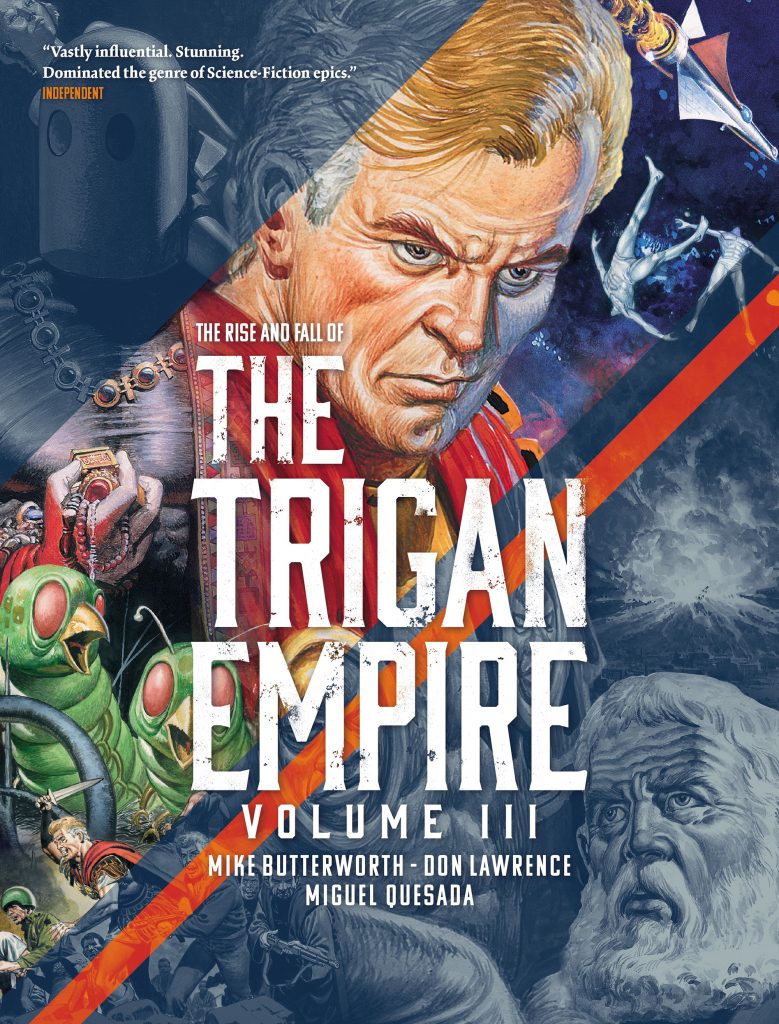
By Mike Butterworth and Don Lawrence
Additional Strip by Miguel Quesada
Published by the Treasury of British Comics
Out: Now
For 20 years, beginning in 1962, Look and Learn was the one comic parents could be counted on to approve of. It was filled with beautifully illustrated text articles covering sport, science, geography, and a somewhat jingoistic version of history. It was the weekly purchase you could easily persuade Mums and Dads to make, even those who disapproved of other comics as either trash or dangerously subversive political propaganda, after all, it was educational.
From June 1966, many Look and Learn readers, would ignore the worthy, educational stuff and turn first, to a beautifully painted, science fiction, comic strip featuring future technology, monsters and men with swords wearing costumes taken from the days of the Roman Empire.
“The Rise and Fall of the Trigan Empire” was a unique and stylish mixture of science fiction, fantasy and a bizarre version of ancient Roman society that mixed swords and sandals with technology. It featured incredible, painted artwork by an already well-established comics professional, Don Lawrence, that gave the rocket ships and monstrous beasts something of a classical air.
The strip had begun in the first issue of Ranger, in September 1965, where it shared billing with an early, and inferior, translation of the adventures of Asterix, under the title, “Britons Never, Never, Never Shall Be Slaves!”. Lawrence had been offered the job illustrating “The Rise and Fall of The Trigan Empire” after the publisher saw a single colour episode of his “Karl the Viking” in the 1965 Lion Annual. The strip that he and writer Mike Butterworth went on to produce was to become one of the best remembered and most influential of its time, even if much of the influence was felt outside of the British Isles.
Ranger had been the sister comic to Look and Learn, with an emphasis on comic strips and adventure. Both were printed at a larger size than most comics of the time and with higher production values, this was reflected in the price. At 1s (one shilling, 5p), Ranger and Look and Learn were expensive. Indeed, for the same price as a copy of either you could have bought The Beano and The Dandy, with enough change left for a copy of Lion as well.
When Ranger was absorbed into Look and Learn, the nature of the surviving title changed. It went from a purely educational magazine into a mixed title that retained the approval of parents, but gave kids a little bit more of the entertainment they wanted.
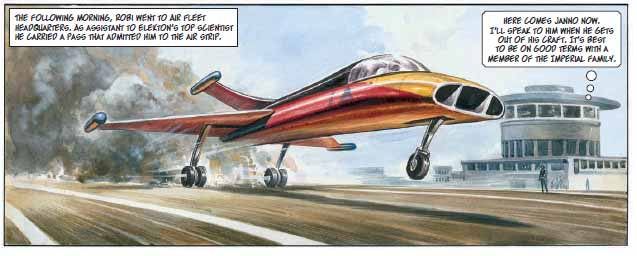
“The Trigan Empire” was a key part of that change and would survive until Look and Learn finally ceased publication in 1982. Several artists would paint the strip, but it is, quite rightly, Don Lawrence who is most associated with it.
Rebellion’s reprint project, publishing all stories in order, has now reached its third volume, with strips from 1971, the time when I first discovered the strip. They are using a re-lettered version of the strip, produced mainly from the original art, that was previously published in large-sized, beautifully produced, limited edition hardbacks by The Don Lawrence Collection, based in Holland.
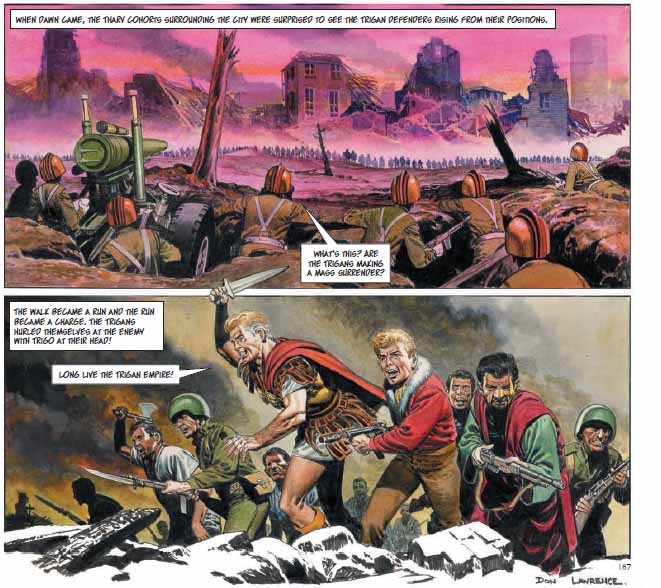
The reproduction is superb, and the re-lettering a vast improvement over the original. It is noticeable that the Title Bar that sat atop the first page of each weekly two-page episode has been removed, leaving extra white space at the bottom of those pages.
Also missing is the short text, usually used for a recap of what has gone before that was placed within the title bar. It’s a minor point, but I do think, that for completeness’ sake, it might have been an idea to include the title bar on the first episode of each story as writer Mike Butterworth often started his set-up in that space.
For example, missing from the very first story, “The Menace of the Deep“, are the lines, “Disaster! The great liner Daveli, largest and newest passenger ship on the planet Elekton, is sinking on her maiden voyage”… Clearly intended as part of the introduction to the strip.
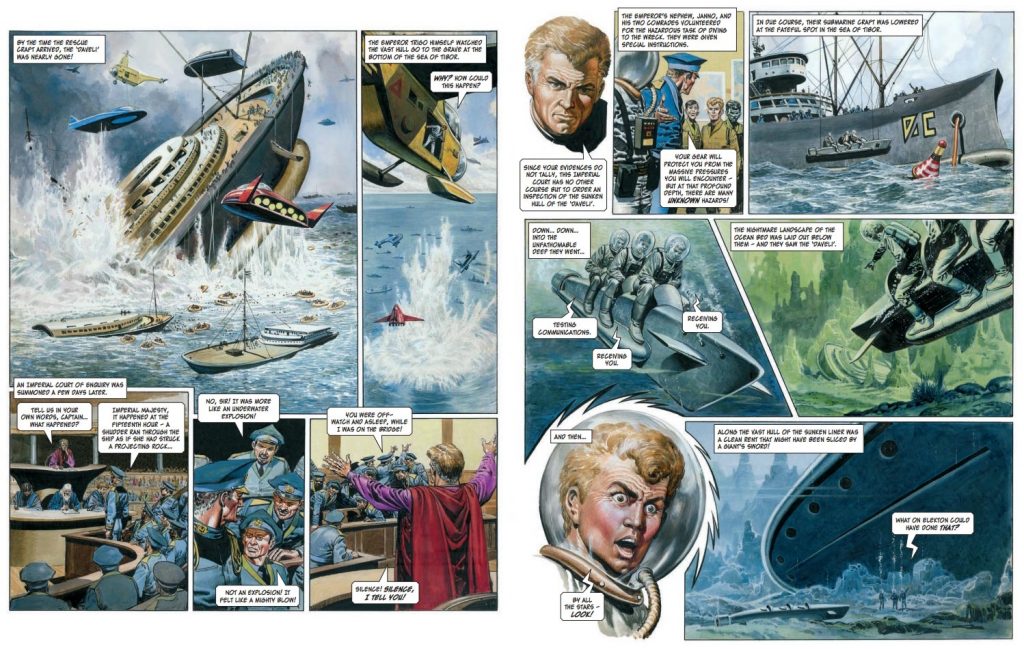
Butterworth’s scripts reflect a different type of storytelling than that seen in current comics. With just two pages a week, everything was, necessarily, compressed. Plots needed to be set up quickly and huge events were often conveyed in a single panel or, as in the example above, a short sentence or two in a caption. This style, often used in the factual, strips on history or exploration, in Look and Learn, somehow added to the epic, legendary quality of the tales, giving them the gravitas of a real future history.
By the time the stories in the current volume were being published, Butterworth was moving away from plots that focused closely on the Imperial Family, with many of the serials dealing with the theme of the place and impact of the ‘outsider’ in a highly ordered society. They focus on threats to the Empire and the Imperial Family from alien invasions, treacherous servants and old friends who have betrayed their rulers.
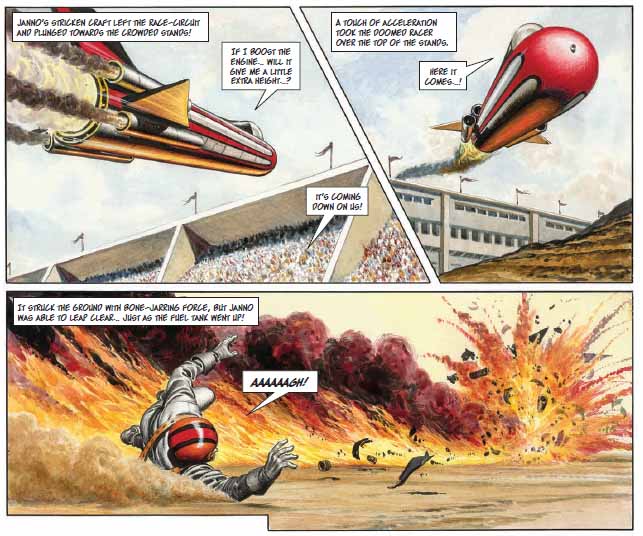
Throughout, you can spot places where Butterworth has used real-life incidents or stories from popular culture to give him a starting place. There are stories or episodes that seem to draw on the fate of the RMS Titanic, or the story of Gollum from Lord of the Rings – and even a famous Star Trek episode, that itself was an adaptation of an older science fiction story, “Arena”.
All the tales are told efficiently and effectively, with a somewhat imperialistic morality which can jar modern readers from time to time, but Butterworth’s plots and ideas seem mainly designed to give Lawrence the change to paint something spectacular.
And that is the true joy of the book. Don Lawrence takes full advantage of every opportunity. Sea monsters, alien war machines, hordes of rampaging horsemen, even a Mr. Hyde rip-off, all are beautifully rendered. His character design is flawless, as a child I was terrified by, “The Masked Raiders” from the story of the same name, or toy assassins, from “The Miniature Killers of Zelph”, and his design of future tech matched anything from Thunderbirds or any other sci-fi of the time.

Even as a young reader, you knew this was a special strip, with a special artist. When Lawrence was replaced, for six issues, by the superb Miguel Quesada, something was missing. The Quesada strip is included in this volume, left out of the earlier Dutch reprint, and excellent it is too, but not quite as good as Lawrence’s work – or as well reproduced, I fear.
If ever a strip belonged in the Treasury of British Comics, then this is it. For those, like me, who remember it, it brings back memories of something we knew was very special at the time, and for newcomers, Don Lawrence’s art will stun them as much as it did me all those years ago.
Trigan’s Rival: Storm
The popularity and quality of “The Trigan Empire” ensured that it was soon translated and published across Europe. Ironically, it was only in 1976, at a comic convention, that Lawrence discovered the extent of the international reprint program and fell out with his publishers over the lack of any additional payments.
He quit the strip and was lured away to work on “Storm“, a strip created for the Dutch weekly comic, Eppo, which debuted in the edition dated 18th March 1977.

The early stories, featuring Storm, an astronaut from earth who is dragged into the great red spot in Jupiter’s atmosphere and sent forward in time to a post-apocalyptic earth known as the Deep World, ruled by barbaric kingdoms and ruthless warlords, were pedestrian and are notable only for the introduction of, Ember, a beautiful red-headed companion and Lawrence’s continued excellence.
Ember, also known as, Roothaar, quickly became an iconic character, who allowed Lawrence to add an element of glamour to the swords, science and fantasy that had been the mainstay of the male dominated, Trigan Empire.
The strip, was incredibly popular in Holland, earning Lawrence, a reputation and popularity, unknown for a comics artist in the UK. Indeed, he was eventually appointed as a, “Knight of the Order of Orange-Nassau”, the rough equivalent of an OBE in British terms.
After nine albums produced between 1978 and 1982, The Deep World, which hadn’t been a great concept to start with, was becoming tired as a setting and in a final album, written by Lawrence himself, Storm and Ember were transported to the multiverse of Pandarve, allowing new writer, Martin Loedwijk, to revitalise the strip and turn it into something very strange and very special.

In all, Lawrence would go on to paint twenty-two volumes of Storm. His final story, running through the last three albums, features some of the best art of his career.
Beautiful and wildly imaginative, those three albums feature characters from all over popular culture, from Alice and the White Rabbit to Marilyn Monroe. There is a robotic Sherlock Holmes. Boer War soldiers and brief appearances by The Lone Ranger, Greta Barbo and Margret Thatcher. There is even, in one panel, a cheeky reference to a well know, but Dreddful lawman.

It was an incredible farewell to the world of comics, possibly his best ever work and it is a shame it not better known in his native country.
So popular was the Storm series that it was revived, in 2007 for, Myx magazine, with art by Dutch artist, Romano Molenaar, who, while staying true to Lawrence’s character and world design, has a style more influenced by American comics. By not imitating Lawrence, and going his own way, he has at once taken advantage of the legacy left by Lawrence, and managed to make the strip his own.
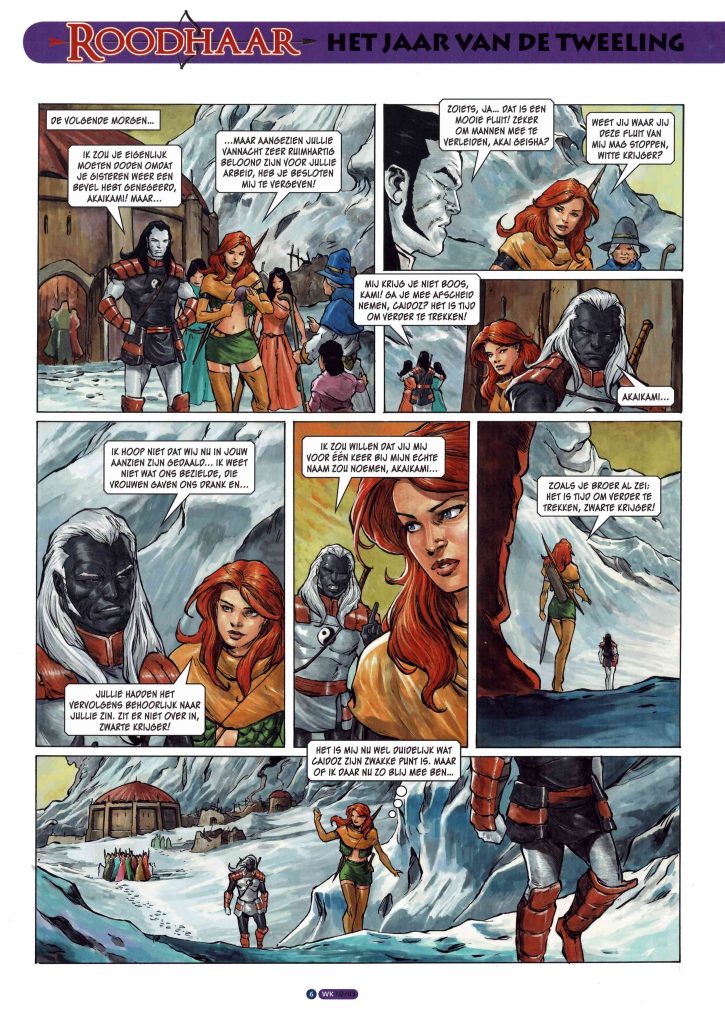
Now back, in a revived Eppo magazine, Storm has recently spawned a spin-off series featuring the glamorous Ember, the first episode of which was written by Roy Thomas, creator of that other red-haired warrior, Red Sonja.

How ironic that, Don Lawrence, one of the most revered artists in British comics, has spawned a series all but unknown to British readers, but which is constantly in print over much of Europe and continues to this day
That this work, from a grand master of British comics is only available in English in a very limited edition of expensive hardbacks is a travesty and one I hope some publisher will put right, although it might be an idea to skip some of the early volumes.
In the meantime, “The Rise and Fall of the Trigan Empire” remains one of the high watermarks of UK comics and an essential part of any collection of British comics.
Peter Duncan
• The Rise and Fall of the Trigan Empire Volume Three is available now (AmazonUK Affiliate Link)
• Buy The Rise and Fall of the Trigan Empire Volume One (AmazonUK Affiliate Link)
• Buy The Rise and Fall of the Trigan Empire Volume Two (AmazonUK Affiliate Link)
• In the Spotlight: “Storm” by Martin Lodewijk and Don Lawrence
A Modern Homage to Don Lawrence
Lawrence’s influence on Dutch comics goes much deeper than just Storm. The Lost Tales of Lemuria, a series written by Sytse Algera, a serving Officer in the Dutch Police, and drawn by Indonesian artist Apri Kusbiantoro, harks back to both Storm and The Trigan Empire, in both story and art.
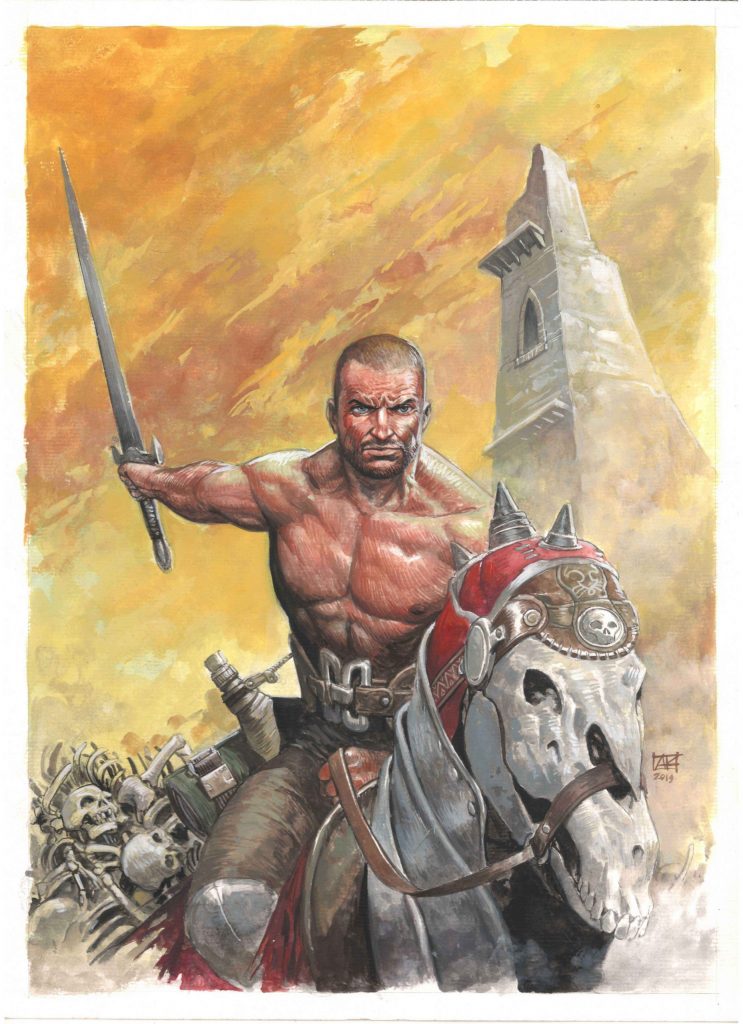
The pair’s story, “Close Call”, published in Heavy Metal 270, even namechecks Trigo and the planet Elekton. It’s a familiar mix of swords, science fiction and strange alien creatures, opened the door for the Lemuria series.
An English language version of the first volume of The Lost Tales of Lemuria has been published by Heavy Metal’s Virus imprint. The English translation is stiff and ill-edited, but Kusbiantoro’s artwork more than makes up for it.
Peter Duncan is editor of Sector 13, Belfast’s 2000AD fanzine and Splank! – an anthology of strips inspired by the Odhams titles, Wham!, Smash! and Pow! He’s also writer of Cthulhu Kids. Full details of his comics activities can be found at www.boxofrainmag.co.uk
Categories: British Comics, British Comics - Collections, Classic British Comics, Comics, downthetubes Comics News, downthetubes News, Features, Reviews

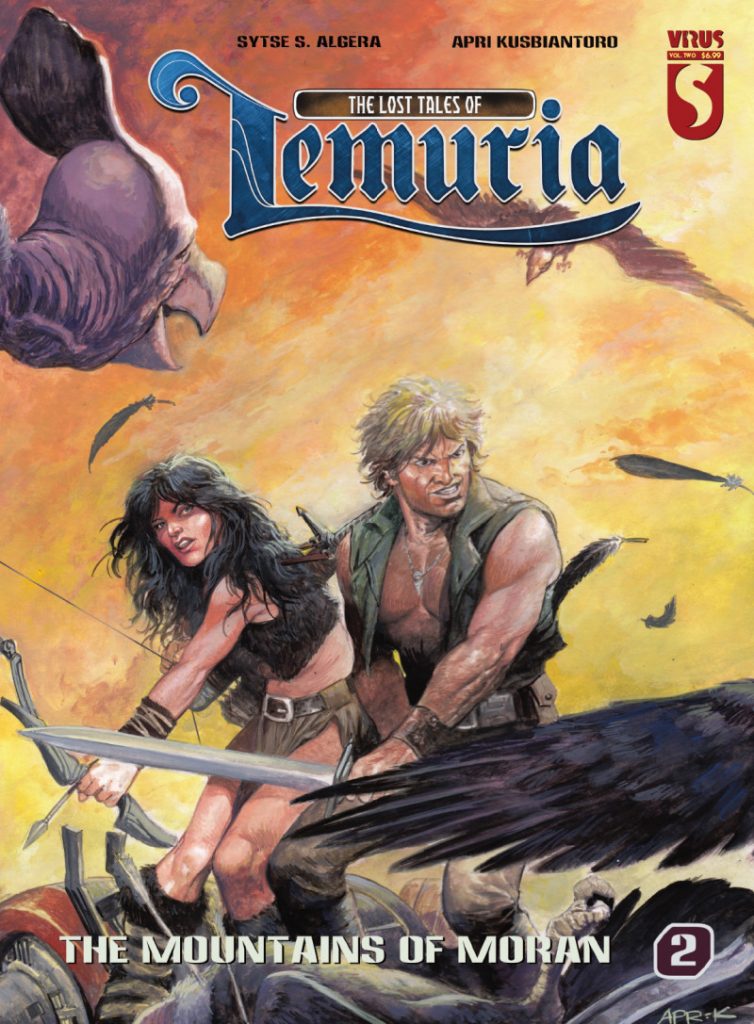
Are there plans to publish in English the Storm saga after Don Lawrence died?
Hi Antonio. An English translation of Storm is already available for a long time. https://www.donlawrenceshop.com/en_GB/c-3939116/storm-the-collection/